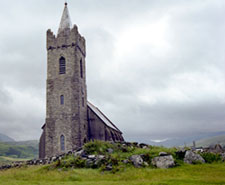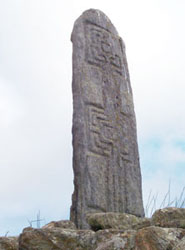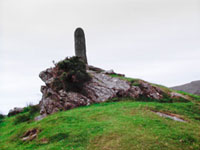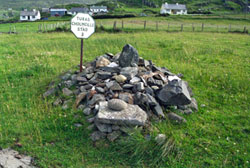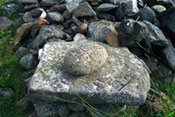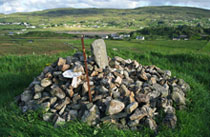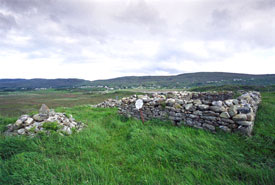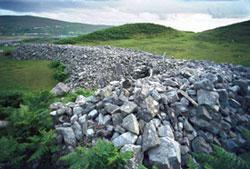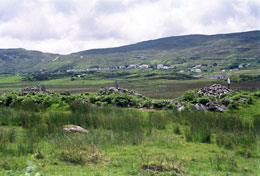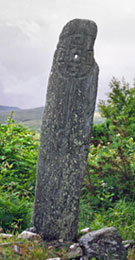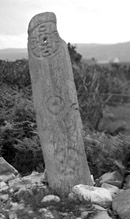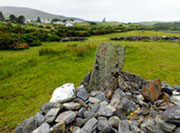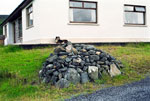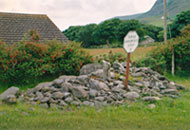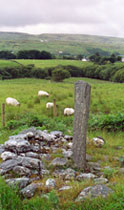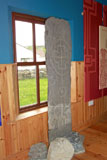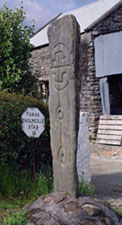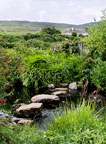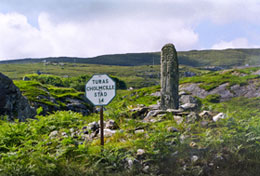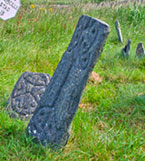10 May Stations of the Gleann Cholm Cille Turas: A Gazetteer
Gleann Cholm Cille (Glencolumcille) — An Turas — The Journey
“The stories preserve the enchanted landscape; the well and other places like it literally hold the stories. Those raised with the stories need only to hear the name of a given place…to rehear the story that is tied to the place…Perhaps it is less a question of whether or not one “believes” the story than of a landscape that has stories in it—stories it can tell you…”
Lawrence J. Taylor, Occasions of Faith, 1995 1
At the western end of Co. Donegal’s Slieve League Peninsula, Gleann (as it’s known to locals) was described by John O’Donovan in 1838 as “the extreme brink of the world, far from the civilization of cities, and the lectures of the philosopher.”2 Now, with the M3-N3 routes connecting Dublin to Cavan, one can travel from the center of the capital to Gleann Cholm Cille in less than four hours.
The history of the Gleann Cholm Cille (Glencolumcille) Turas is discussed in some detail on our other page devoted to this site. Turas Cholmcille is performed (by its purists) trekking barefoot, starting just after midnight as June 9th begins. Walking for five and a half kilometers (3.5 miles), the pilgrims visit 15 stations and perform specific prayers and devotions at each. The stations are mostly decorated cross-slabs set into rough rock cairns.
These slabs, composed of schist, have crosses and other design elements cut into them. A few of the slabs, at the west end of the valley, have been shaped into rudimentary crosses. The cross-slabs can be divided into two groups, with those in the east, closer to the town, showing more elaborate decorations, some of them similar to that of eighth- or ninth-century metalwork. The slabs found in the stations of the lowland areas and the hills to the west of town have markings that are more rudimentary, cut into the stones as simple outlines.
As the stations are visited in turn, each is circled three times in a “sunwise” direction (deiseal) so that the station is always to the right as the pilgrim makes a clockwise circuit from east to south to west to north around each monument. Until the pilgrim begins the walk down the hill to Station Seven, the only words spoken should be in prayer.
The stáisiúin (stations) of the Turas are presented here in numerical order, which is replicated in the Virtual Turas on this site. In traditional Gleann Cholm Cille community life, however, the stations were referred to by their names, not numbers. And in walking the Turas the villagers would begin at whatever station was closest to their homes. The station numbers that are used in Voices from the Dawn may not always be consistent with signage or with other sources of information. The numbers used here were determined by consulting with authorities in Gleann Cholm Cille who study traditional practices and by seeking out those who carry on the traditions locally.
There was once more than the one Turas in this little valley. There were other journeys up and down the nearby hills to commemorate the lives and works of other local saints. These practices have now been lost forever, fading first into a dim folk memory and then into but a sentence in a dusty book.3 The Turas of St. Colm Cille was the one that survived. We are fortunate that it did, as otherwise we would never have had the opportunity of sloshing through the fields in the pouring rain at midnight on the eve of June 9th, 2001, holding an umbrella in one hand and a night-vision camcorder in the other.
This Turas was not saved by good fortune alone. When Liam Price came here for his research in 1940 he sought the help of local folklorist Seán Ó hEochaidh, who led him to the recollections of an old woman named Peigí Mhór ni Ghadhra. Thus some of the traditional lore was committed to paper.4 When Fr. James McDyer encouraged archaeologist Michael Herity to come here to do his field research and then publish his Gleanncholmcille guidebook in 1971, he set in motion a process that today continues with religious, cultural, and archaeological tourism. These have guaranteed a steady stream of visitors eager to walk these sacred ancient paths. Many of them are the enthusiastic Irish-speaking students attending classes at the Oideas Gael Irish language cultural center in town. Like Fr. McDyer’s Folk Village, these students, and all who walk the Turas paths, are part of the living tradition in this sacred landscape of St. Colm Cille.
“Man looks with veneration upon every spot that has been hallowed by sincere religion…and feels anxious…to preserve every trace by which the turas of the pilgrim and the progress of the human mind in art, religion, or enthusiasm can be followed.
…
I hope that all these places are carefully set down…The theatre of the solemn pilgrimage of Columbkille which extended for three miles along the Glen should be carefully shown…and all the wells and other footsteps of the Saint and his followers, the pilgrims.” 5
John O’Donovan, 1838
In the gallery below are black and white photographs of some of the cross-slabs. These images, taken from a 1941 journal article,6 show the inscribed designs with more detail than is evident in some of our contemporary images. This may be due to erosion that has occurred in the stones during the intervening 70 years. Or, it may also be possible that there was, in the earlier images, some retouching of the negatives to help delineate the inscriptions.
Station One (Straid townland)
An altar on a ruined megalithic tomb
The first station of An Turas is built right into the west retaining wall of the graveyard of St. Columba’s Church (Church of Ireland). It is possible that this church, built in 1828 to replace an earlier Protestant structure, stands on land where there was an early-Christian monastic enclosure.
The souterrain found when digging a grave in the churchyard in 1832 may date from this period (c. eighth century).7
But four thousand years before that, this spot was where a group of Neolithic farmers built a megalithic Court Tomb. This place, therefore, has been considered sacred for thousands of years. It is possible that stones from this 10-meter (33-feet) long monument were quarried and used in the construction of monastery buildings or churches at this site.8 At the west side of the ruined tomb is a small place for the pilgrim to kneel.
This station, like all the others, is circled three times by the pilgrim, always walking clockwise around the stones. The prayers to be said here, while kneeling, are the Credo, five Our Fathers, and five Hail Marys. The pilgrim then places his back to the stone and renounces “the World, the Flesh and the Devil.”
The pilgrim then walks two fields to the west, to the next station. While walking between the stations of the Turas, the fifteen decades of the rosary are recited. These prayers must be completed three times before reaching the final station.
Station Two (Straid townland)
A cross-pillar on a rock outcrop
One hundred meters (328 feet) west of Station One there is a 1.85-meter (six-feet) high cross-inscribed schist stone pillar standing at the top of a small but prominent rock outcrop. Beneath the pillar are the remains of a leacht, a dry-stone altar. Probably the best known and most photographed of all the Turas monuments, its two broad faces contain designs including three ornamental panels on the east face and a four-part design on the west face.
Archaeologist Peter Harbison suggested that there is a resemblance in the design to a finger, perhaps intended to depict a metal reliquary containing the finger of St. Colm Cille.9
The ornamental panels may be viewed in detail in the virtual-reality object to the left. Click on the image, then drag to rotate the pillar after the new window fully loads.
At one time this stone marked the western limit of An Turas, before the stations up on the mountain—Colm Cille’s Bed (Station Five), and Well (Station Six)—were added.10 The pilgrim circles three times sunwise, then climbs up to the stone, kneels, and says five Our Fathers, five Hail Marys, five Glorias, and the Creed.
Station Three (Garveross townland)
Áit na nGlún, “The Place of the Knees”
This small cairn, 1.2 kilometers (.75 mile) north-west of the previous station, measures 2.9 meters by 2.2 meters (9.5 x 7.2 feet).
Next to the cairn is a flat slab, with a round stone set on top of it. After making the three circuits of the cairn while saying the prayers (three Our Fathers, three Hail Marys, three Glorias, and the Creed), the pilgrim then passes the round stone around his body three times, repeating, “In the name of the Father, the Son, and the Holy Ghost.”
Formerly there were three rounded stones waiting for the pilgrims. Áit na nGlún refers to the depression in the earth where the pilgrim kneels, just west of the cairn.
Station Four (Beefan townland)
Mullaí na Croise, “Height of the Cross”
This stone altar, 400 meters (1,312 feet) north up the hill from Station Three, sits within a circular dry stone wall with a diameter of 10.75 meters (35.3 feet). This may have been the remains of some sort of prehistoric monument.11 Between this Station and the next is a small circular structure, apparently the base of a small hut.
The entrance of the enclosure points to the east. Atop the leacht is a meter- (3.28 feet-) tall rock slab inscribed with a weathered Latin cross. The pilgrim makes the three rounds here, while reciting five Our Fathers, five Hail Marys, five Glorias, and the Creed. The name given for this location, Mullaí na Croise (“Height of the Cross”), encompasses both Stations Four and Five.
Station Five
Cill Cholm Cille, “Colum Cille’s Chapel”
This station is immediately north of Station Four. The most significant of the structures within this 18-meter (59-feet) circular enclosure is the small roofless mortared building known as Cill Cholm Cille, “Colm Cille’s Chapel.” Being only 6 meters by 3.4 meters (19.7 by 11.2 feet) it was probably not built as a church but rather as a shrine (reliquary-house). It is possible that missionaries from Colm Cille’s monastery in Iona came here with relics of the saint and deposited them in this building. This may explain why the 2-meter (6.6-feet) flagstone top of a cist in the northeast corner of the Chapel is called Leaba Cholmcille, “Colm Cille’s Bed.”
The pilgrim circles the chapel three time, clockwise, while praying. After the third time he enters the building and lies down on Colm Cille’s Bed. He then rotates his body while horizontal, always turning first onto the right side. From underneath the Bed the pilgrim may take a handful of clay, which is supposed to prevent fires in the home and provide a cure for headaches.
In a little recess above the bed there were kept three stones, one with a small incised cross. The pilgrim would make the Sign of the Cross on his eyes using one of these Cloche na Suile, or “Eye Stones.” These may now have gone missing, because there “is hardly a place from here to America to which they are not sent [for cures] …people say that when Columcille used to lie down in the Bed at night he use to lay this stone over his eyes to put him asleep.” Before leaving the chapel, one must pass these three stones three times round the hands, the feet, and the head, in the name of the Father, the son and the Holy Ghost.12
There are also three eroded cross-topped cairns inside the circular enclosure. Each of the cairns is thrice circled during An Turas, the pilgrim saying the Creed, five Our Fathers and five Hail Marys.
To the east, just outside the enclosure, a flat boulder with a circled cross inscribed on top is called Leac na hAchainí, the “Flagstone of the Request.” This stone is said to grant the pilgrim’s wish if she walks around it three times, in prayer, and then jumps off of it. It is also known as Leac na mBonn, the “Flagstone of the Soles of the Feet.”
After leaving this stone, the pilgrim is supposed to proceed around the bottom of Mullacb na Croise, keeping the Chapel and the cairns on the right as he proceeds to the next Station.
Station Six (Beefan townland)
Tobar Cholm Cille, “Colm Cille’s Well”
To reach Station Six, the pilgrim must climb up a steep hill, carrying with him three stones gathered at the bottom of the hill. Midway up to Colm Cille’s Well there is a natural rock outcrop in the form of a seat. This very logical place to sit and survey the valley panorama below on a fine day is called Colm Cille’s Chair, as the faithful believe that the saint himself once rested here.
Proceeding up to the cairn containing the well, the pilgrim circles it three times, each time depositing on the immense curved 30-meter (100-feet) pile one of the stones carried up the hill, thus doing his part to extend it a bit. While making the rounds, ten Our Fathers, ten Hail Marys, ten Glorias, and the Creed are said.
Afterward, one should kneel at the recess of the well, genuflect, and drink from the water, using one of the cups provided. The pilgrim should first spill three drops from the cup, in the name of the Father, the Son, and the Holy Ghost.
Often some water is carried away in a bottle, either kept by the pilgrim or sent off to someone in need of a cure. In a 1941 report it was noted that, “no stopper should be put into the bottle but one of the grass which is growing round the well.”13 Above the well is a 92-centimeter (36-inch) rough stone cross, with incised designs. There is a modern statue of a saint to the side of the well.
Over the years an eclectic collection of personal mementos has been left on the altar above the well by pilgrims seeking a blessing of the saint. It is said that “you must leave something for what you take away.”14
On the path down the hill to the next Station, pilgrims may talk casually for the first time, as the only voices heard prior to this point should be in prayer. This hill is called Mullaigh na Cainnt, “the Slope of the Conversation.”
Station Seven (Ballard townland)
Garraí an Turais, “The Garden of the Turas,” or
Lios Chaigh, the “Holy Enclosure”
Down the hillside, 400 meters (1,312 feet) from Colm Cille’s Well, there is a D-shaped dry-wall enclosure which contains three cairns, with upright cross-slabs. Pilgrims circle each of the cairns three times, while reciting the Our Father and the Hail Mary each time around. At one of the cairns there was a flat stone which, to cure a sore throat, the pilgrim would raise up to her chin.
The western cairn has a slab set deep within its base, with only 70 centimeters (27.5 inches) visible above the base. There is an outline of a Latin cross incised on its north west face.
The central cairn is a leacht with a rectangular base that is 4.5 meters (18.8 feet) square. It has an entrance passage leading into its center.
The eastern cairn, also a leacht with a rectangular base, has a rudimentary cross that is 85 centimeters (33.5 inches) tall. The left-hand arm of the cross was apparently broken off.
The path to the next Station then enters Abar Dubh (the Black Swamp) for the wet trek forward. There, pilgrims wash their feet in the depression in a boat-shaped stone called Umar Ghlinne, the “Trough of the Glen” (also called St. Colum Cille’s Boat). The water there was said to have curative powers, being especially good at treating warts. In a 1941 account of the stone’s lore, it was said that if war should come to Gleann Cholm Cille the only people who would survive would be the ones standing on this stone, “but if that should occur the stone would burst and submerge the whole glen.”15
The path through the bog can be inundated at flood tides; an alternative route to the next Station is to backtrack by roads.
Station Eight (Farranmacbride townland)
Cloch an Aonaigh, “The Stone of the Assembly”
After sloshing through Abar Dubh for 1.2 kilometers (.75 miles) the pilgrim approaches Station Eight by the side of a roadway. Just before reaching the Station, however, An Turas passes by a ruined Court Tomb, originally 60 meters (197 feet) in length. Locally known as Mainnear na Mortlaidh (“Enclosure of the Dead”), this monument may have been associated with the traditions of the Turas.16
Station Eight is a beautifully inscribed cross pillar that is nearly two meters (6.5 feet) tall. It sits in a low cairn, with its decorated face turned to the pilgrims as they emerge from Abar Dubh. The design work includes three circular elements, connected by a vertical line. On the upper panel is a symmetrical cross, contained in a circle, with a perforation at its center. To see all the details, click on the black and white image to the right. Then, in the new window, click the “full screen” button. You can then use the controls to zoom in.
The name of this Station may be derived from the tradition that couples would pledge their engagement by touching their fingers through the hole, from opposite sides of the stone. The ceremony would be watched by an assembly of people, an aonach. A different local tradition holds that the name of the stone is Cloch na Súil, “The Stone of the Eye.”17
Another legend about the hole in the stone says that the pilgrim who is in a state of grace should be able to look through the aperture and get a glimpse of Heaven. A local informant in 1936 said that the visions of heaven had gone away because “”the people are no longer what they used to be, and the class that’s going around now don’t deserve to see such sights.”18
The pilgrim circles the cairn three times, saying five Our Fathers, five Hail Marys, five Glorias, and the Creed. Then, placing his back to the stone, renounces the World, the Flesh, and the Devil (Diulfafm don Diabhal, don Saol, agus don Cholainn). In a 1902 account it was reported that barren women would pray for children at this stone.19
Station Nine (Faugher townland)
A cairn off the roadside
This cairn features a very weathered one meter (3.28 feet) slab of schist, which does not appear to have ever been decorated. From this spot the pilgrim can see St. Columba’s Church in the distance to the south west, the location of the first and the final stations of An Turas. Down the road are the ruins of what is known as the “Spanish Church.”20
Station Ten (Faugher townland)
A cairn by the roadside
This cairn, which the pilgrim circles just as all the others, is an unimposing little pile of stones, lacking a pillar. It seems, in fact, to be a modern addition, with its stones missing the patina of age and the ornaments of lichen found on the other cairns. But that is only because the stones were recently moved away for safekeeping during the construction of the adjacent residence. The cairn was then reassembled in its current location, which may be seen in the virtual-reality environment. The image here shows the cairn before the construction activity.
Station Eleven (Faugher townland)
A cairn by the roadside
A diminutive slab, only 40 centimeters (15.7 inches) high, pokes up from this low cairn. It is either undecorated or so thoroughly weathered that it seems so. This is the most easterly point of An Turas. It is here that the pilgrim turns and begins the walk back west to where she began the journey. Stations 9 – 12 are all found just on the edge of the modern paved road, which, says Michael Herity, would be following “the line of the ancient pilgrim pathway.”21
Station Twelve (Drumroe townland)
Baile na nDeamhan, “The Townland of the Demons”
Within an eroded circular enclosure of approximately 3.7 meters (12.2 feet) in diameter is a flat-topped cross-pillar. This 1.6 meter (5.25 feet) slab retains its ornamentation on both faces. The design on its east side is similar to that on the east face of the cross-pillar at Station Two.
The name of this site, “The Townland of the Demons,” comes from the legendary battle fought here between St. Colm Cille and a band of demons, perhaps an allegory representing the struggle against the remnants of pagan practices in this valley. This story is recounted in our other Gleann Cholm Cille page. In 1941 it was reported that “the old people seldom called the townland Druim Ruadh; Baile na nDeamhan was the name all the old people called it.”22 Nearby is Poll an Chloig, “The hollow of the Bell,” where Colm Cille is said to have thrown his bell at the demons, chasing them into the sea.
The pilgrim here recites five Our Fathers, five Hail Marys, five Glorias and the Creed while circling the cairn.
Station Thirteen (Gannew and Curreen townland)
A cross pillar in the road by the Garda Station
If there is any one station of An Turas likely to be seen by all visitors to Gleann Cholm Cille it would be this one, as it sits right on the main road, by a junction to one of the routes into town.
The 1.6 meter (5.25 feet) pillar, standing in a small cairn, is a fiberglass reproduction cast from the damaged original stone, which has now been reassembled and is displayed in the village Folk Museum. The decorated side of the pillar faces east, toward the pilgrims as they approach from the Townland of the Demons. At this station the prayers recited are three Our Fathers, three Hail Marys, three Glorias, and the Creed.
Station Fourteen (Cashel townland)
A cairn and pillar on a rocky outcrop near a stream
After walking 400 meters (437 yards) south from Station Thirteen, the pilgrim crosses the river Muirlin by stepping stones and then approaches Station Fourteen on a rocky prominence just south of the stream. There is a decorated slab, 1.1 meters (3.5 feet) high, standing on a leacht. It is decorated on its north-east face. The pilgrim recites three Our Fathers, three Hail Marys, three Glorias, and the Creed.
This station may be reached more easily by a path leading from the rear parking area of the housing estate to its south.
Station Fifteen (Straid townland)
A cross pillar in the Church of Ireland graveyard
Pilgrims again cross the river Muirlin and then head up the hill back to St. Columba’s Church where An Turas began. In the Catholic (east) section of the church graveyard there is a now-broken pillar that was 1.8 meters (5.9 feet) tall when it was whole. The knotted-ribbon patterns, and the complex key designs on the top section of the stone are unusual among the cross pillars.
At this station pilgrims recite five Our Fathers, five Hail Marys, five Glorias, and the Creed. Although this is the last station of the Turas, final prayers are said at the first station, the ruined prehistoric tomb at the west wall of the churchyard.23
Sources used for the information about the stations of the Turas in this gazetteer include:
Cunningham, Gerard. Turas Cholm Cille – A Pocket Guide. Dublin: Faduca, 2010.
Harbison, Peter. Pilgrimage in Ireland: the Monuments and the People. Syracuse, NY: Syracuse Univ., 1992.
Herity, Michael. Gleanncholmcille: A guide to 5,000 years of history in stone. Dublin: Na Clocha Breaca, 1998.
Price, Liam. “Glencolumbkille, County Donegal, and Its Early Christian Cross-Slabs.” The Journal of the Royal Society of Antiquaries of Ireland, Seventh 11.3 (1941): 71-88.
Click here to see all the notes from this page.
During the 30 years that our six visits to Gleann Cholm Cille have spanned, a number of locals have kindly offered their assistance with this project. Paddy Beag Gillespie and Jimmy Carr, who have each been leaders of Turas groups, have been generous with their time. They are the Erenaghs, the inheritors of the traditions of this valley. Séamus McGinley has been a careful reader of the text for this site. Paul Cunningham was most helpful when we walked and videotaped the Turas together in 1998. Other members of the community, now deceased, were very helpful in years past: Paddy Byrne, Bridey Cunningham, and John McGuire. On each visit to Gleann we look forward to visiting Oideas Gael and spending time with its indefatigable founder, Liam O’Cuinneagain. He has provided indispensible guidance and suggestions for both the text and the media for this project, suggestions which have made it better at every station along the way.
External Links:









